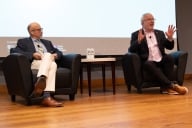You have /5 articles left.
Sign up for a free account or log in.
Outsourcing has been part of the higher-ed business model for long enough that contracting a third party to run the campus bookstore or dining hall is not going to raise any eyebrows. But with the digitization of campus bureaucracy and the introduction of "cloud computing" as a windfall for scholars and IT departments, the outsourcing of information services has become a topic of much excitement — and skepticism — on college campuses.
This is especially true of student e-mail. Nearly half of all institutions have outsourced student e-mail, according to data collected last year by the Campus Computing Project. Some colleges have also outsourced other back-end
operations to information management providers. And scholars now look to cloud services to help them manage and share reams of research data.
Microsoft, for one, is rushing to meet higher education in the cloud. It has trumpeted the resources it is pouring into its cloud platform, Windows Azure. In a podcast interview with Inside Higher Ed this week, Cameron Evans, the company’s top technology officer in the United States, talked up the features of Microsoft SharePoint 2010, which it is marketing to the academic crowd along with its newest version of Microsoft Office. The new version of Office integrates with SharePoint such that far-flung collaborators can work together in Power Point and other Office programs.
“If I’m at University X and you’re at University Y, I don’t have to give you credentials from University X to log into my SharePoint site so that you can find me, find what I’ve published, so that we can collaborate on documents at the same time,” Evans said.
Evans was not shy about criticizing Google, one of Microsoft’s biggest competitors in the market for cloud computing in higher education. “Microsoft defined productivity,” he said. Google, by contrast, is merely “a great company at search.”
The recurring argument against the outsourcing of campus information services has been that outside entities should not be trusted with institutional data. In such a climate, the cloud vendors that stand to get the most traction in the higher-ed market are those that can best reassure colleges that sensitive data will not be compromised and that the information in student e-mail accounts will not be used toward any nefarious corporate marketing schemes.
Apropos, the Microsoft guru was particularly conscious to draw a distinction between Microsoft’s privacy bona fides relative to Google’s. Evans cited the fact that Microsoft does not host user data on servers located outside the United States (as Google does) — a practice that is of concern to research universities that work with sensitive government and business data. He was also careful to note that Microsoft does not “read your mail” or “scan it for use in advertising.”
Jeff Keltner, a business developer at Google, took offense at the implication that Google does read student mail. It does not, he says. (Student e-mail accounts might be analyzed for targeted advertising efforts if they continue using their institutional accounts once they graduate, but Google does not mine their backlogged mail for profiling purposes, Keltner said.) Google only “scans” student e-mail for the purposes of virus protection and spam filtering, he added — a standard practice among cloud e-mail providers, including Microsoft.
“I find it unfortunate that people feel the need to take insinuated potshots,” Keltner said. He then fired a shot of his own, remarking that since Google has been building its privacy and security software to deal with threats from the public Web since its inception, it is better positioned to guarantee the security of cloud data than is Microsoft — which arrived later to the Wild, Wild Web, dragging a “legacy infrastructure, designed to be run on premise, behind a firewall,” Keltner says.
Needless to say, competition for higher education customers is fierce — suggesting a market that is both eager to avail itself of cloud services and in a good position to influence its corporate vendors. For more on how Microsoft is trying to win over academic customers, listen to Inside Higher Ed’s full podcast interview with Evans
For the latest technology news from Inside Higher Ed, follow Steve Kolowich on Twitter.








